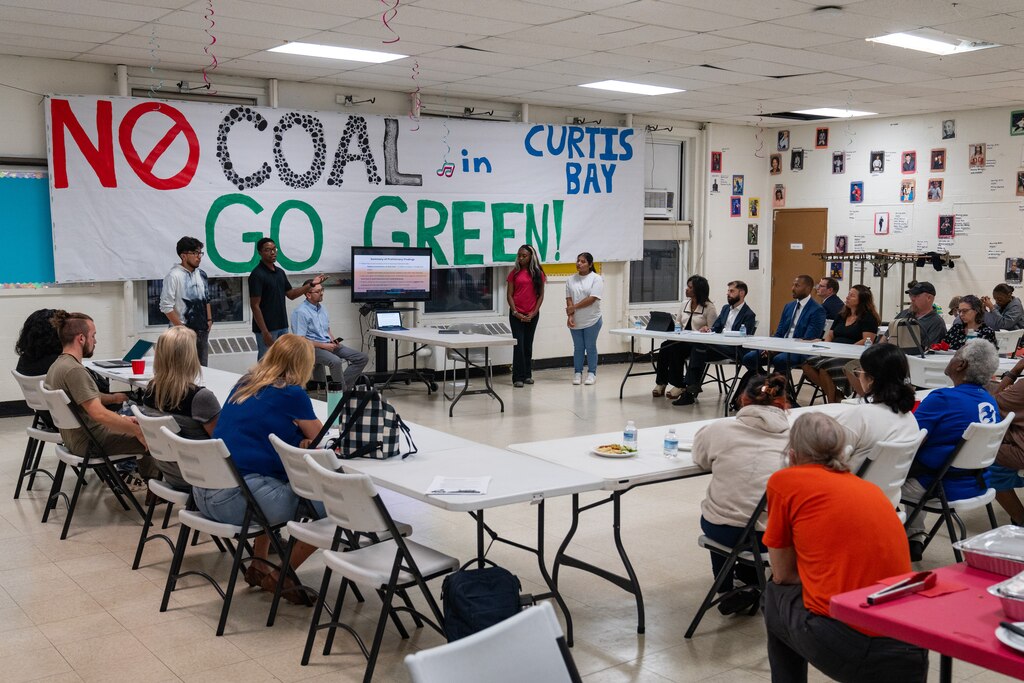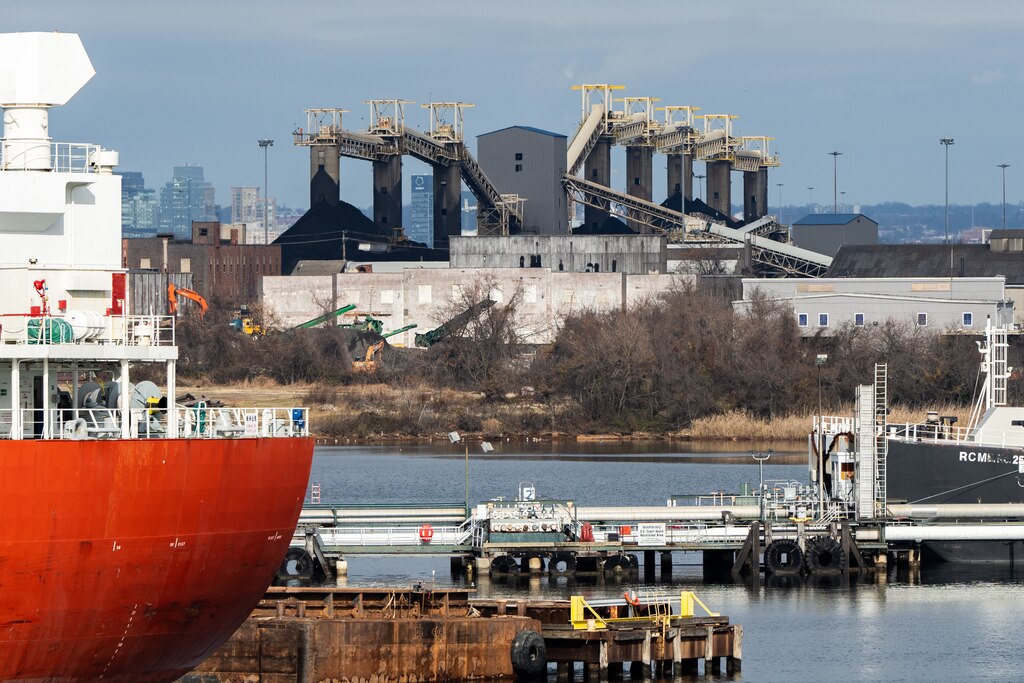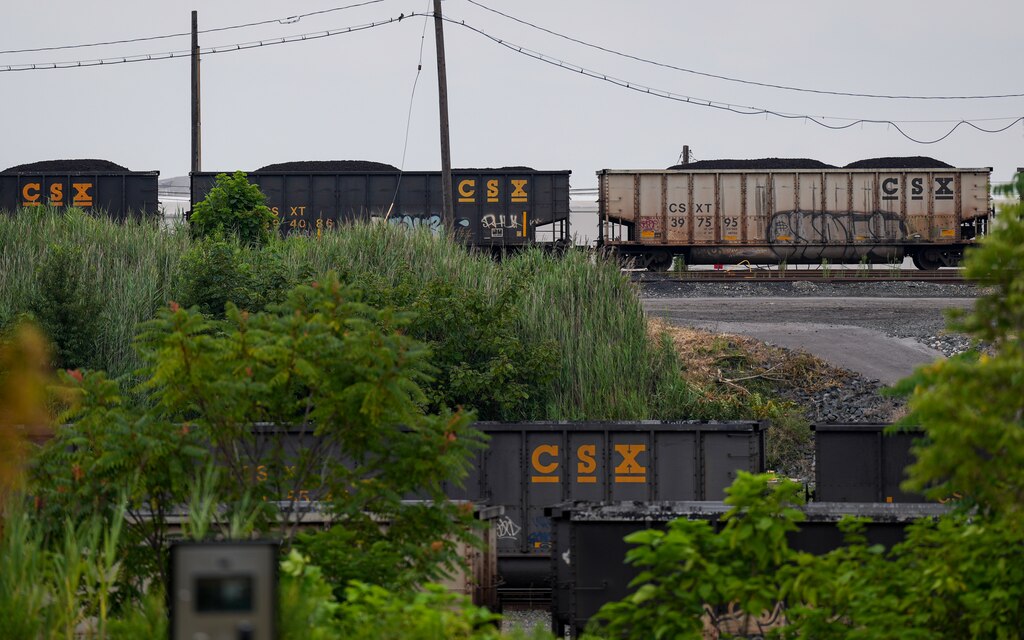Charles Schultz was sitting in his living room when it sounded like a bomb went off. Then the sky turned dark.
Throughout his 50-plus years living in Curtis Bay — an isolated community wedged into the southern corner of Baltimore — he’d gotten used to seeing soot pile up on his windowsill. Now coal dust was raining down onto his street, a tower smoldering on the CSX coal pier just a stone’s throw from his doorstep.
For Schultz and many of his neighbors, the late 2021 explosion was a breaking point, drawing citywide attention they thought might push coal out of their neighborhood for good. Yet years later, Baltimore is exporting record amounts of coal and community members say the neighborhood is still choked by coal dust even as the rest of the country is largely leaving the polluting fuel behind.
The South Baltimore coal piers operated by CSX Transportation, one of the dominant rail companies in the eastern United States, are governed by a state environmental permit, which the company is seeking to renew for the first time since a buildup of methane gas caused the explosion that shook the neighborhood two years ago. The state environmental department is expected to release a preliminary decision on the permit in the coming weeks, the culmination of a monthslong process punctuated by sometimes tense meetings with Curtis Bay residents.
The Baltimore Banner thanks its sponsors. Become one.
There’s reason to believe things might be different this time.
Gov. Wes Moore has set ambitious climate goals that will not only require Maryland to phase out fossil fuels over the next 20 years, but also put new weight on delivering justice for the low-income communities living at the front lines of industry.
While Maryland regulators argue they don’t have the power to shut down the CSX piers — the company is licensed under federal law to export coal — the permit could offer a lever to clamp down on the site. Short of denying CSX its permit, state regulators could mandate stricter protections against coal dust or even force the company to enclose its open-air terminal.
But CSX has rejected state findings about the scope of the problem, and payoff for coal leaving the Port of Baltimore is big. The state’s impending decision comes as business at Baltimore’s two coal terminals has reached an all-time peak — and as officials in the Moore administration remain almost singularly focused on fully reopening the port in the wake of the March Francis Scott Key Bridge collapse.
Already the second largest coal terminal in the United States, exports through the Port of Baltimore soared last year, leaving Curtis Bay at the mercy of a voracious international appetite for coal.
The Baltimore Banner thanks its sponsors. Become one.
Some longtime residents of the neighborhood are resigned to a future in which coal trains keep rolling through their neighborhood and mountains of coal keep stacking up next-door.
They’ve seen their pleas ignored plenty of times before.
“CSX ain’t gonna do nothing for you, and the politicians ain’t doing nothing about it,” said Schultz. “So this is where you’re at.”

A legacy of coal dust
Curtis Bay’s coal transport hub was constructed nearly 150 years ago, in 1882, then under the ownership of CSX’s grandparent, the B&O Railroad. Through the generations, many neighborhood residents have worked at the coal piers, shedding soot-covered clothes before stepping into their homes at the end of long days, according to Cornell University environmental anthropologist Chloe Ahmann, a former teacher in the neighborhood.
Today, CSX’s relationship with the neighborhood is more tense, and several residents said they don’t know anyone who works at the facility.
The Baltimore Banner thanks its sponsors. Become one.
The coal piers and other heavy industry almost kept Tiffany Thompson from moving to this neighborhood. A former teacher at Curtis Bay Elementary School, she said she had taught too many kids suffering from childhood asthma.
Years later, though, Thompson, now 50, and her two sons found housing in Curtis Bay through the nonprofit South Baltimore Community Land Trust. They’ve come to love the sense of community there.
Residents can no longer be content to live this way, with CSX making money while the community’s health suffers, she said. “I am very optimistic about the community getting some justice.”
Over the last 15 months, regulators with the Maryland Department of the Environment have spent hours meeting with residents at the Curtis Bay Recreation Center, just across the road from the coal terminal, hashing out coal’s future in the neighborhood.
Often, officials have fielded frustration and sharp criticism. But they have also promised to come out with the strongest permit they can in the wake of the explosion.
The Baltimore Banner thanks its sponsors. Become one.
“We know it’s coal dust,” Maryland Secretary of the Environment Serena McIlwain told residents at one of those meetings more than a year ago, pledging to move beyond “rhetoric” to address environmental injustices. “You have to be blind not to see what’s going on in this community.”

The environmental department even sponsored a report, alongside citizen scientists and Johns Hopkins University researchers, stating officially for the first time that the film coating the homes and cars of Curtis Bay residents is indeed coal.
Still, it remains unclear just how far McIlwain and her agency will go.
MDE declined to make anyone available for an interview about CSX’s operations, and a spokesperson didn’t specify how the agency’s oversight might change under a new permit.
Regulators are “carefully reviewing evidence” from last year’s coal dust report to develop the terms of the draft permit, said spokesperson Jay Apperson. The Maryland Department of the Environment already imposed additional dust control requirements on CSX, including installation of a fence-line monitoring system, when it greenlit repairs in the wake of the explosion, and when it cited the company for the incident months later, he noted.
The Baltimore Banner thanks its sponsors. Become one.
Apperson did not directly answer a question about whether the regulators are considering requiring CSX to cover its facility completely, a measure some residents said they see as a minimum first step. Maryland wouldn’t be the first to take this route: Advocates have pointed to coal pile enclosure requirements enforced by both the Chicago Department of Public Health and Southern California air quality regulators as examples officials here could follow.
CSX, though, has maintained that it is already taking the necessary steps to contain pollution.
In response to emailed questions from The Banner, the Jacksonville, Florida-based company pointed to investments it has made into technology to keep coal dust from wafting off of the property, including spraying down coal piles with water, setting up wind barriers and covering the conveyors that move coal off of trains.
“CSX is deeply committed to safe and environmentally sound operations” at its Curtis Bay facility, spokeswoman Sheriee Bowman said in a statement. Bowman did not answer several specific questions, including how often CSX douses its coal piles with water, how many Curtis Bay residents are employed at their neighborhood’s coal piers, or whether CSX officials have met with community members about their concerns.
CSX has also refuted the state and community’s findings about coal dust in the neighborhood, alleging their collaborative report “relied on flawed approaches to draw unfounded conclusions.” In the 121-page response, assembled by third-party consultants, the company argued that state regulators should not base any permitting decision on the report.
The Baltimore Banner thanks its sponsors. Become one.
Pollutants stem from dozens of industrial sources around Curtis Bay, the response notes, and the state-backed report fails to provide evidence proving that coal dust from the CSX site has had a significant impact on the neighborhood’s air quality.

Big coal, big profit
While the U.S. has steadily weaned itself off of coal power since the late 2000s, international demand is growing. Last year, global coal consumption hit a historic peak.
So did coal exports at the Port of Baltimore.
Between the CSX piers and a separate coal terminal across the water, the Port of Baltimore exported almost 28 million short tons of coal last year, up nearly eightfold since 2002.
That’s partly because Appalachian coal is quality stuff, said Ryan Driskell Tate, an analyst of international coal markets for the Global Energy Monitor.
These days, most of this rock ends up in India — the second largest coal consumer in the world, whose coal demand is expected to keep growing through at least the end of the decade. There, it burns to keep lights on, cool homes and manufacture bricks.
It’s also spewing climate-warming emissions into the atmosphere in volumes that rival Maryland’s own carbon footprint. Since 2002, coal exported through the Port of Baltimore has driven over a half-billion metric tons of CO2 emissions in other parts of the world, according to calculations supplied by Christine Shearer, a researcher with Global Energy Monitor.
While coal shuttled through the Port of Baltimore fuels greenhouse gas emissions overseas, the Moore administration is charting an ambitious course to all but erase Maryland’s emissions by 2045. That net-zero target is among the most ambitious in the country, but it doesn’t factor in the emissions generated from the coal passing through Schultz’s neighborhood from West Virginia, on its way to faraway kilns.
If state leaders want to crack down this humming export economy, the implications for the Port of Baltimore could be far-reaching.
In an economic impact analysis provided by CSX, the company claims $335 million in value to Maryland and estimates it accounted for $21 million in corporate, property, income and other local taxes in 2022. CSX has also pledged up to $170 million for the renovation of the Howard Street Tunnel, which will clear way to handle many more shipping containers at the port, and the company’s trade in coal has helped secure funding to dredge a deeper channel that has brought in bigger ships and larger volumes of other commodities.
A recent analysis by the Maryland Port Authority estimates that coal exports support more than 700 jobs at the Port of Baltimore.
CSX notes that some of its coal burns nearby, helping to power Maryland homes, and not all of the coal moving through Baltimore stops in Curtis Bay.
While regulators have paid intense scrutiny to the CSX’s Curtis Bay coal piers, even more rock flows through a separate terminal across the water. Located by the eastern portals of the I-895 and I-95 tunnels south of Canton Crossing, the Consol Marine terminal has seen massive accumulation, too, exporting even more coal than the CSX facility in the past five years, according to data provided by the company.
Last renewed in June 2022, Consol’s current state environmental permit expires in 2027.
The purview of state regulators also runs out quickly. In Curtis Bay, CSX owns not just the coal piers but the rail lines feeding into them — under federal jurisdiction.
There may still be ways for the state to impose its climate priorities on the rails. MDE’s own climate plan, published in December, floated the idea of a tax on companies that transport hazardous substances — including fossil fuels — through the state as a way to fund the state’s green energy transition. One bill in Annapolis this year would have levied this tax on coal transport, specifically, and allocated a cut of the revenues to frontline communities like Curtis Bay.
The bill didn’t get far, though. And while South Baltimore advocates and environmental groups across the country have called on the U.S. Environmental Protection Agency to require rail companies to cover their coal cars, for now no such national standard exists.
Last summer, advocates with the South Baltimore Community Land Trust went to Maryland Senate President Bill Ferguson seeking support in their cause. During a video call, which was recorded by advocates and posted online, Ferguson said he’s supportive of measures to mitigate the impacts of pollution at both terminals, but emphasized the economic importance of coal exports to the port, calling an immediate shutdown “draconian, to say the least.”
One caller clarified that advocates weren’t looking for an overnight transition, but for a leader who would champion a longer-term pathway to phasing coal out of the neighborhood.
“I’m glad that this is being moved forward,” responded Ferguson, whose district includes the port and Curtis Bay. “I wish I could say it was going to be the top thing that I am focused on.”

Power players
Of the 886 miles of rail track in Maryland, most are owned by CSX. Coal is by far the highest volume commodity shipped on the state’s railways.
”How do we fix this 150-year-old economy that is embedded” in society? asked Del. Robbyn Lewis, whose South Baltimore district also encompasses Curtis Bay.
It’s a complicated question, Lewis argued, and one she said only she and a small group of lawmakers in Annapolis are trying to resolve. After the explosion in the last days of 2021, Lewis said she tried immediately to get a meeting with the company, but the process took months and little came of it when it finally happened.
In Annapolis, CSX has had an active presence, spending hundreds of thousands of dollars lobbying during the 2022 session and arguing against proposed laws that would impose stricter safety regulations on railroads or establish a climate tax on fossil fuel businesses.
The rail company has given thousands of dollars to city and state elected officials in recent years. That includes $8,500 for Ferguson since the 2022 cycle, on top of $23,500 for Moore’s gubernatorial campaign and his pricey 2023 inauguration ball, according to state campaign finance records.
A spokesperson for Moore’s office did not respond to questions about calls to end coal exports in Curtis Bay or CSX’s influence on policymaking. In a statement, Ferguson said Maryland must protect front-line communities as the state transitions from polluting fuels and said regulators should include “all commercially reasonable environmental protections” in CSX’s new permit.
Though the U.S. role in global coal export markets remains relatively small, companies will make the supply available as long as demand is there, said Tate, the coal market analyst. And even as many countries turn to alternative fuel sources, demand for the coal coming through the Port of Baltimore may hinge on behemoth buyers like India deciding they no longer want it.
For now, the second largest consumer of coal in the world isn’t slowing down: India’s target for achieving net-zero emissions isn’t until 2070.
That could leave residents like Schultz or Thompson with a hard decision.
Thompson is worried about the health of her grandmother, now in her 90s, and said she plans to leave Curtis Bay to take care of her. To Thompson, moving her grandmother into the neighborhood to breathe its polluted air isn’t an option.
Still, she gets wistful thinking about the move.
”Like, ‘Oh, this is my house.’ Like, ‘This is my community,’” she said. “I love this community. But I’m not going to sacrifice my grandmother’s health any more than it is.”



Comments
Welcome to The Banner's subscriber-only commenting community. Please review our community guidelines.